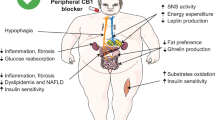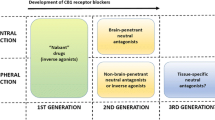Abstract
-
▴ Rimonabant is the first of a new class of selective cannabinoid receptor-1 blockers. It reduces the overactivity of the endocannabinoid system, improving lipid and glucose metabolism and regulating food intake and energy balance.
-
▴ In four randomised, double-blind clinical trials in overweight or obese adults with or without type 2 diabetes and/or dyslipidaemia, oral rimonabant 20mg once daily reduced weight and waist circumference to a significantly greater extent than placebo.
-
▴ A significantly greater proportion of rimonabant than placebo recipients achieved the clinically significant weight-loss target of ≥5% or ≥10% of initial weight.
-
▴ Rimonabant was associated with significant improvements in glycaemic control relative to placebo, with ≈57% of the reduction in glycosylated haemoglobin being independent of the effects of weight loss in one trial.
-
▴ Improvements in other cardiometabolic risk factors (i.e. increases in high-density lipoprotein-cholesterol [HDL-C] and decreases in triglyceride [TG] levels) were significantly greater with rimonabant than with placebo.
-
▴ The improvement in lipid profile also demonstrated a weight-independent effect, with ≈47–58% of the mprovement in HDL-C and TG being beyond that expected through weight loss alone.
-
▴ Rimonabant was generally well tolerated, with most adverse events considered mild to moderate in severity.




Similar content being viewed by others
Notes
The use of trade names is for product identification purposes only and does not imply endorsement.
References
World Health Organization. Obesity and overweight. 2006 [online]. Available from URL: http://www.who.int/ [Accessed 2006 Jul]
National Institutes of Health. Clinical guidelines on the identification, evaluation, and treatment of overweight and obesity in adults. NIH Publication No. 98-4083 [online]. Available from URL: http://www.nhlbi.nih.gov [Accessed 2006 Jun 25]
Ioannides-Demos LL, Proietto J, Tonkin AM, et al. Safety of drug therapies used for weight loss and treatment of obesity. Drug Saf 2006; 29(4): 277–302
Piomelli D. The molecular logic of endocannabinoid signalling. Nat Rev Neurosci 2003 Nov; 4(11): 873–84
Boyd ST, Fremming BA. Rimonabant: a selective CB1 antagonist. Ann Pharmacother 2005 Apr; 39(4): 684–90
Pagotto U, Marsicano G, Cota D, et al. The emerging role of the endocannabinoid system in endocrine regulation and energy balance. Endocr Rev 2006 Feb; 27(1): 73–100
Engeli S, Bohnke J, Feldpausch M, et al. Activation of the peripheral endocannabinoid system in human obesity. Diabetes 2005; 54: 2838–43
Bensaid M, Gary-Bobo M, Esclangon A, et al. The cannabinoid CB1 receptor antagonist SR141716 increases Acrp30 mRNA expression in adipose tissue of obese fa/fa rats and in cultured adipocyte cells. Mol Pharmacol 2003 Apr; 63(4): 908–14
Osei-Hyiaman D, DePetrillo M, Pacher P, et al. Endocannabinoid activation at hepatic CB1 receptors stimulates fatty acid synthesis and contributes to diet-indiced obesity. J Clin Invest 2005; 115(5): 1298–305
Liu YL, Connoley IP, Wilson CA, et al. Effects of the cannabinoid CB1 receptor antagonist SR141716 on oxygen consumption and soleus muscle glucose uptake in Lep(ob)/Lep(ob) mice. Int J Obes Relat Metab Disord 2005 Feb; 29(2): 183–7
Matias I, Gontheir M-P, Orlando P, et al. Regulation, function and dysregulation of endocannabinoids in models of adipose and beta-pancreatic cells and in obesity and hyperglycaemia. J Clin Endocrin Metab 2006; 91(8): 3171–80
Di Marzo V, Matias I. Endocannabinoid control of food intake and energy balance. Nat Neurosci 2005 May; 8(5): 585–9
Bluher M, Engeli S, Kloting N, et al. Dysregulation of the peripheral and adipose tissue endocannabinoid system in human abdominal obesity. Diabetes 2006 Nov; 55(11): 3053–60
Data on file, Sanofi-Aventis, 2006
Rinaldi-Carmona M, Barth F, Heaulme M, et al. Biochemical and pharmacological characterisation of SR141716A, the first potent and selective brain cannabinoid receptor antagonist. Life Sci 1995 May 5; 56: 1941–7
Rinaldi-Carmona M, Barth F, Heaulme M, et al. SR141716A, a potent and selective antagonist of the brain cannabinoid receptor. FEBS Lett 1994; 350(2-3): 240–4
Jbilo O, Ravinet-Trillou C, Arnone M, et al. The CB1 receptor antagonist rimonabant reverses the diet-induced obesity phenotype through the regulation of lipolysis and energy balance. FASEB J 2005 Jul 11; 19(11): 1567–9
Cani PD, Montoya ML, Neyrinck AM, et al. Potential modulation of plasma ghrelin and glucagon-like peptide-1 by anorexigenic cannabinoid compounds, SR141716A (rimonabant) and oleoylethanolamide. Br J Nutr 2004 Nov; 92(5): 757–61
Poirier B, Bidouard JP, Cadrouvele C, et al. The anti-obesity effect of rimonabant is associated with an improved serum lipid profile. Diabetes Obes Metab 2005 Jan; 7(1): 65–72
Gary-Bobo M, Elachouri G, Scatton B, et al. The cannabinoid CB1 receptor antagonist rimonabant (SR141716) inhibits cell proliferation and increases markers of adipocyte maturation in cultured mouse 3T3 F442A preadipocytes. Mol Pharmacol 2006 Feb; 69(2): 471–8
Cota D, Marsicano G, Tschop M, et al. The endogenous cennabinoid system affects energy balance via central orexigenic drive and peripheral lipogenesis. J Clin Invest 2003; 112(3): 423–31
Di Marzo V, Goparaju SK, Wang L, et al. Leptin-regulated endocannabinoids are involved in maintaining food intake. Nature 2001 Apr 12; 410(6830): 822–5
Kirkham TC, Williams CM, Fezza F, et al. Endocannabinoid levels in rat limbic forebrain and hypothalamus in relation to fasting, feeding and satiation: stimulation of eating by 2-arachidonoyl glycerol. Br J Pharmacol 2002; 136: 550–7
DeVries TJ, deVries W, Janssen MCW, et al. Suppression of conditioned nicotine and sucrose seeking by the cannabinoid-1 receptor antagonist SR141716A. Behav Brain Res 2005 Jun 3; 161(1): 164–8
Arnone M, Maruani J, Chaperon F, et al. Selective inhibition of sucrose and ethanol intake by SR 141716, an antagonist of central cannabinoid (CB1) receptors. Psychopharmacology (Berl) 1997 Jul; 132: 104–6
Ravinet-Trillou CR, Arnone M, Delgorge C, et al. Anti-obesity effect of SR141716, aCB1 receptor antagonist, in diet-induced obese mice. Am J Physiol Regul Integr Comp Physiol 2003; 284: R345–53
McLaughlin PJ, Winston K, Swezey L, et al. The cannabinoid CB1 antagonists SR 141716A and AM 251 suppress food intake and food-reinforced behavior in a variety of tasks in rats. Behav Pharmacol 2003 Dec; 14(8): 583–8
Despres JP, Golay A, Sjostrom L, et al. Effects of rimonabant on metabolic risk factors in overweight patients with dyslipidemia. N Engl J Med 2005 Nov 17; 353(20): 2121–34
Ravinet Trillou C, Arnone M, Delgorge C, et al. Anti-obesity effect of SR141716, aCBl receptor antagonist, in diet-induced obese mice. Am J Physiol Regul Integr Comp Physiol 2003 Feb; 284(2): R345–53
Acomplia: summary of product characteristics [online]. Available from URL: http://www.emea.eu.int/ [Accessed 2006 Jul 20]
Turpault S, Woolfrey S, Lockwood GF, et al. Effect of orlistat on the pharmacokinetics of rimonabant [abstract]. Clin Pharmacol Ther 2006 Feb 1; 79(2): 77
Ferron GM, Grandison M, Lockwood G. Population pharmacokinetic analysis of rimonabant in healthy subjects [abstract no. PI-136]. Clin Pharmacol Ther 2005 Feb; 77(2): 43
Turpault S, Kanamaluru V, Lockwood GF, et al. Rimonabant pharmacokinetics in healthy and obese subjects [abstract]. Clin Pharmacol Ther 2006; 79(2): 50
Turpault S, Kanamaluru V, Lockwood GF, et al. Lack of effect of rimonabant on the pharmacokinetics of nicotine [abstract]. Clin Pharmacol Ther 2006; 79(2): 24
Kanamaluru V, Lockwood G, Bonnet D, et al. Lack of effect of rimonabant on the pharmacokinetics of digoxin [abstract]. J Clin Pharmacol 2005; 45(9): 1081
Kanamaluru V, Lockwood G, Bonnet D, et al. Lack of effect of rimonabant on the pharmacokinetics of oral contraceptives [abstract]. J Clin Pharmacol 2005; 45(9): 1082
Grandison M, Kanamaluru V, Lockwood G, et al. Lack of effect of rimonabant on the pharmacokinetics and pharmacodynamics of warfarin [abstract]. J Clin Pharmacol 2005; 45(9): 1082
Grandison M, Kanamaluru V, Lockwood G, et al. Lack of effect of rimonabant on the pharmacokinetics and pharmacodynamics of midazolam [abstract]. J Clin Pharmacol 2005; 45(9): 1082
Van Gaal L. Rio-Europe: 2 year results [oral presentation]. 54th Annual Scientific Session of the American College of Cardiology; 2005 Mar 6–9; Orlando (FL)
Van Gaal LF, Rissanen AM, Scheen AJ, et al. Effects of the cannabinoid-1 receptor blocker rimonabant on weight reduction and cardiovascular risk factors in overweight patients: 1-year experience from the RIO-Europe study. Lancet 2005 Apr 16; 365(9468): 1389–97
Pi-Sunyer FX, Aronne LJ, Heshmati HM, et al. Effect of rimonabant, a cannabinoid-1 receptor blocker, on weight and cardiometabolic risk factors in overweight or obese patients: RIO-North America: a randomized controlled trial. JAMA 2006 Feb 15; 295(7): 761–75
Scheen AJ, Finer N, Hollander P, et al. Efficacy and tolerability of rimonabant in overweight or obese patients with type 2 diabetes: a randomised controlled study. Lancet. Epub 2006 Oct 27
Cleeman JI. Executive summary of the third report of the National Cholesterol Education Program (NCEP) expert panel on detection, evaluation, and treatment of high blood cholesterol in adults (adult treatment panel III). JAMA 2001; 285(19): 2486–97
Van Gaal L, Scheen A, Despres J-P, et al. Effect of rimonabant on systolic and diastolic blood pressure in overweight/obese patients with/without co-morbidities [abstract]. The 16th Scientific Meeting of the European Society of Hypertension; 2006 Jun 12–15; Madrid
Author information
Authors and Affiliations
Corresponding author
Rights and permissions
About this article
Cite this article
Henness, S., Robinson, D.M. & Lyseng-Williamson, K.A. Rimonabant. Drugs 66, 2109–2119 (2006). https://doi.org/10.2165/00003495-200666160-00006
Published:
Issue Date:
DOI: https://doi.org/10.2165/00003495-200666160-00006




